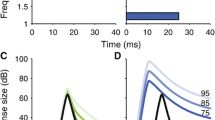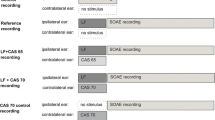Summary
As it was still not possible to elucidate sufficiently the function of the efferent acoustic system or the tractus olivocochlearis (OCB), and as it is still not known whether this system possibly has the function of providing protection against noise-induced trauma, the vestibular nerve was severed in the guinea pig, and the threshold shift was compared with that of a control group. On day 8 after exposure to noise, both the temporary threshold shift (TTS) and the permanent threshold shift (PTS) were significantly lower in the control group than in the group with severed OCB. Thus, it does indeed seem possible to ascribe a protective function to the efferent system.
Similar content being viewed by others
References
Aran JM, Charlet de Sauvage R (1975) Normal and pathological adaptation of compound VIII nerve responses in the guinea pig. Acta Otolaryngol (Stockh) 79: 259–265
Buno W Jr, Velluti R, Handler P, Austt GE (1966) Neural control of the cochlear input in the wakeful free guinea pig. Physiol Behav 1: 23–35
Capps MJ, Ades HW (1968) Auditory frequency discrimination after transection of the olivocochlear bundle in squirrel monkeys. Exp Neurol 21: 147–158
Dayal VS (1972) A study of crossed olivocochlear bundle on adaptation of auditory action potentials. Laryngoscope 82: 693–711
Fex J (1959) Augmentation of cochlear microphonic by stimulation of efferent fibres to the cochlea. Acta Otolaryngol (Stockh) 50: 540–541
Flock A, Russel I (1973) Efferent nerve fibers: Post-synaptic action on hair cells. Nature [New Biol] 243: 89–91
Galambos R (1956) Suppression of auditory nerve activity by stimulation of efferent fibers to cochlea. J Neurophysiol 19: 424–437
Igarashi M, Cranford JL, Nakai Y, Alford BR (1979) Behavioral auditory function after transection of crossed olivocochlear bundle in the cat. IV. Study on pure-tone frequency discrimination. Acta Otolaryngol (Stockh) 87: 79–83
Kupperman R (1972) Cochlear adaptation, central influences. Acta Otolaryngol (Stockh) 73: 130–140
Pfalz RKJ (1969) Absence of a function for the crossed olivocochlear bundle under physiological conditions. Arch Klin Exp Ohr-Nas-Kehlkopf-Heilkd 193: 89–100
Rasmussen GL (1942) An efferent cochlear bundle. Anat Rec 82: 441
Trahiotis C, Elliott DN (1970) Behavioral investigation of some possible effects of sectioning the crossed olivocochlear bundle. JASA 47: 592–596
Author information
Authors and Affiliations
Rights and permissions
About this article
Cite this article
Handrock, M., Zeisberg, J. The influence of the efferent system on adaptation, temporary and permanent threshold shift. Arch Otorhinolaryngol 234, 191–195 (1982). https://doi.org/10.1007/BF00453630
Accepted:
Issue Date:
DOI: https://doi.org/10.1007/BF00453630




